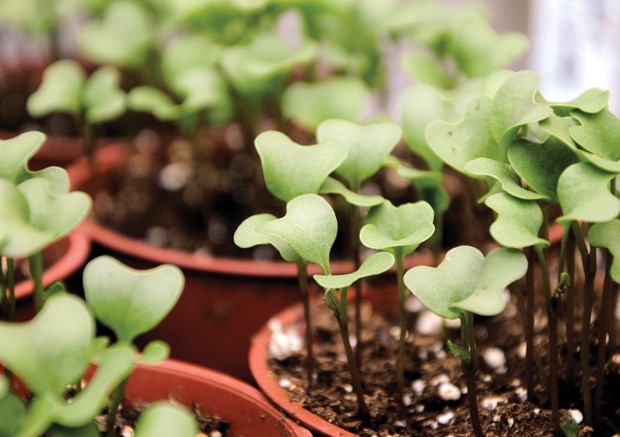May is the month that always makes me really excited about my vegetable patch.
It’s encouraging to see the early seeded greens taking off with vibrant leaves, and the seedlings in the greenhouse getting bigger by the day.
Local garden experts agree that spring is early by two to three weeks again this year. We’ve already enjoyed a spell or two of hot sunny weather, and the higher average temperatures in May make it safe to start planting some of the “tender” vegetables (beans, squash, cucumbers, etc.) as our soil temperatures begin to rise.
The May long weekend has been a traditional weekend to plant out these tender seedlings and seeds, but with this early spring you could be bold and experiment with early planting. If your seeds fail to germinate because your soil is too cold, just try again near the end of the month. You can pick up a small soil thermometer at the garden centre for about $10, which comes with a chart of soil temperatures that will yield the best germination rates of each crop. This is a fun tool to pick up for those of you who like to take a scientific approach to your veggie patch.
Do not forget to harden off your seedlings before you plant them! Hardening off is the process of acclimatizing seedlings to outdoor temperatures and the elements. I once made the mistake of planting a huge squash patch with seedlings I had not hardened off. It had been hot and sunny for a week, and the weather forecast was great, so I figured that it would be fine to get them in the ground. I was wrong! They suffered from shock and sunburn, and most of them died within a week. The handful that did survive struggled along all season, were stunted, and never thrived. I think I got one little squash out of the whole patch that year.
Now I like to start my hardening off schedule with two to three hours outside in the shade and then back inside for the first two days. Then move to two to three hours of direct sunshine, rest of the day in the shade, and back inside at night. Increase the time spent in the sun by an hour each day until they’re in the sun all day, and then keep them outside overnight in a cold frame or under a row cover. Then they will be ready for the big move outdoors. If you can’t fit this sort of schedule into your life, just do your best to slowly expose them to direct sun and outdoor temperatures, and try to plant them out during an overcast day.
When people ask me why their gardens just never seem to do well despite their attention to soil health, composting, sunlight, weeding, and doing everything they can think of “right,” it often comes down to seedling health. It can be very difficult for seedlings to recover if they were not hardened off properly. We also often pick the largest seedlings at the garden centre because we think we are getting the best value for our money and a head start. Not the case! Those seedlings have probably been sitting around on garden centre shelves for too long, may be root bound, and have not been properly fed to keep them in top shape. It’s common to see seedlings with lower leaves beginning to yellow or purple on the shelves. These are stressed and will take longer to recover when you bring them home. Always go for the smallest and most tender seedlings; under your excellent care they will grow to be strong and healthy!
There are probably a few of you thinking that you just don’t have time to deal with all these seedlings, their hardening off schedules, and other demands, but you still want a vegetable garden. Self-seeding vegetables are the ones for you! Plant these once, let them flower and go to seed and at the end of the season you’ll always have a fresh crop. Pick open-pollinated varieties instead of F1 (or hybrid) varieties; you’ll find this information on the front of the seed package. Pick and choose your favourites from this list: arugula, mache, purple orach, chard, kale, radicchio, purselane and mustard greens.
Happy gardening!
Emily Jubenvill grew up on the North Shore and is passionate about growing fresh organic food. When she’s not in the garden you’ll find her on a mountain or by the sea. She’s the manager of the North Shore Neighbourhood House’s Edible Garden Project, and you can reach her at [email protected] or ediblegardenproject.com.



